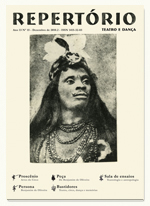<b>A PALHAÇARIA EM O SAPATO DO MEU TIO</b> <br> [Demian Moreira Reis]
DOI:
https://doi.org/10.9771/r.v0i15.5222Resumo
Neste artigo analiso a palhaçaria no espetáculo O sapato do meu tio. A peça O sapato do meu tio foi inspirada na obra de Peter Handke, O menor quer ser tutor, que pode ser aproximada ao teatro do absurdo. Mas a fórmula principal do espetáculo equaciona teatro e palhaçaria. Diversos dispositivos da técnica do palhaço foram reconhecidos, como o estabelecimento de uma relação de Branco e Augusto na relação entre o Tio e o Sobrinho; a quebra da quarta parede, estabelecendo uma relação de jogo direto com a platéia, principalmente na cena do espelho quebrado, mas também em outros momentos pelo espetáculo; a dilatação e o exagero de características físicas e da personalidade de cada ator na atuação das personagens; a feitura de cenas curtas e independentes, cuja montagem não obedeceu a uma lógica de causalidade, proporcionando um efeito de surpresa maior; o uso da máscara do nariz vermelho e sapatos grandes e vermelhos, indumentária típica da palhaçaria clássica, para caracterizar as cenas de apresentação artística do Tio e o número do espelho quebrado. Assistimos a esses princípios operando, sobretudo nas ações físicas dos atores do espetáculo, apesar de apresentar uma situação dramática, isto é, um enredo que pretende sustentar algum grau de verossimilhança. A peça não usa diálogo falado, portanto, depende principalmente dos recursos apresentados pelo corpo cênico dos atores.In this article I analise the clownery in the spectacle My uncles shoes. The play My uncles shoes was inspired in the play of Peter Handkle, The minor wants to be a tutor, which can be approximated to the theater of the absurd. But the main formula of the show tackles theater and clownery. Several devices of the clown technique was recognized as establishing a relationship of White and August in the relationship between uncle and nephew, breaking the fourth wall, establishing a direct gaming relationship with the audience, especially at the scene of the mirror broken, and other moments of the spectacle, the dilation and exaggeration of physical featuresand personality of each actor in the role of the characters, the writing of short and independent scenes, whose assembly did not follow the logic of causality, providing an effect of surprise, the use of mask of a red nose and big red shoes and red, clothing typical of the classic slapstick to characterize the artistic presentation of scenes of the Uncle and the number of the broken mirror. We saw these principles operating, especially, in the physical actions of the actors of the show, which despite having a dramatic situation, that is, a plot that aims to sustain some degree of verisimilitude. The play does not make use of spoken dialogue, and therefore depends mainly on the resources presented by the scenic body of the actors.
Downloads
Não há dados estatísticos.
Downloads
Publicado
2010-07-07
Como Citar
Repertório, T. & D. (2010). <b>A PALHAÇARIA EM O SAPATO DO MEU TIO</b> <br> [Demian Moreira Reis]. Repertório, (15), 165–175. https://doi.org/10.9771/r.v0i15.5222
Edição
Seção
BASTIDORES
Licença
Os/as usuários/as poderão ler, baixar, copiar, distribuir, imprimir os textos integralmente desde que sejam claramente mencionadas as referências aos/às autores/as e à Revista Repertório. A utilização dos textos em outros modos depende da aprovação dos/as autores/as e deste periódico.
Os conteúdos emitidos em textos publicados são de responsabilidade exclusiva de seus/suas autores/as e não refletem necessariamente as opiniões da Revista Repertório.








